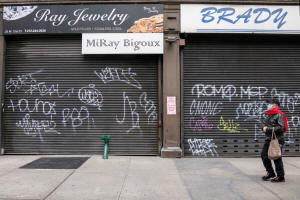After two lost decades, U.S.'s weakest local economies may face worse
from pandemic
 Send a link to a friend
Send a link to a friend
 [October 14, 2020]
By Howard Schneider [October 14, 2020]
By Howard Schneider
(Reuters) - A decade-long economic
expansion did little to narrow the gaps between the United States'
prosperous and ailing areas, with thousands of "distressed" zip codes
shedding jobs and businesses in a trend that laid the groundwork for the
developing "K" shaped recovery from the coronavirus pandemic.
New analysis from the Economic Innovation Group studying economic
patterns across roughly 25,000 zip codes showed that from 2000 through
2018, already prosperous areas pulled further ahead, capturing
disproportionate shares of the jobs created and the new businesses that
were formed.
For 5,000 or so "distressed" zip codes it was by contrast a period of
lost opportunity as they fell further behind, with the number of jobs
declining even deep into the recovery, and those that remained more
concentrated in industries and occupations likely to have been disrupted
by the pandemic.

Economists analyzing the U.S. path to recovery are worried that inside
national measures of economic growth lie deepening divisions between
industries and people as some sectors recover fast, while employment in
the leisure and hospitality industry, for example, remains 20% below
where it was in February.
Such service sector workers, the EIG found, made up a disproportionate
share of workers in areas already falling behind economically.
"Communities that were already vulnerable going in, that had already
been largely overlooked by the period of growth preceding the pandemic,
are the most vulnerable to its effects," said EIG President John
Lettieri.
Within the roughly 5,000 worst-off zip codes nearly a quarter of working
adults were employed in service occupations as of 2018.
By contrast, in prosperous zip codes only 13% of employed adults were in
service jobs, while half were in management or professional occupations,
a group of jobs considered more adaptable to work-from-home
arrangements.
[to top of second column]
|

A man wearing a mask walks past shuttered businesses on Broadway in
the Manhattan borough of New York City, U.S., April 25, 2020.
REUTERS/Lucas Jackson/File Photo

The study combines a variety of statistics on education, poverty rates
and employment into an index that divides U.S. zip codes into five
groups, with the top 20% considered "prosperous" and the bottom
considered distressed.
The study did document improvement. Around 33 million more Americans
were living in "prosperous," "comfortable" or mid-tier zip codes in 2018
than in 2000 - prosperity that increasingly moved towards urban areas.
Those zip codes also became more ethnically and racially diverse, with
the share of non-white residents in prosperous areas rising from 16% to
26%. More Americans in distressed areas are also graduating high school.
But the gaps remained large. The number of Americans living in
distressed areas remained about 50 million, unchanged since 2000, and a
disproportionate share were Black and Hispanic. About 56% of Blacks and
45% of Hispanics lived in economically distressed or at-risk areas.
From 2000 through February 2020, the United States went through two
recessions, one of them deep, but also had its longest measured period
of uninterrupted growth.
It did little to change the economic landscape, with roughly two-thirds
of zip codes remaining in the same category in which they started. With
a third recession sparked by the pandemic now underway, the divide may
grow deeper.

"All of the gains have gone to higher tiers," said EIG research director
Kenan Fikri. "We have a chronic tail of distressed communities."
(Reporting by Howard Schneider; Editing by Andrea Ricci)
[© 2020 Thomson Reuters. All rights
reserved.] Copyright 2020 Reuters. All rights reserved. This material may not be published,
broadcast, rewritten or redistributed.
Thompson Reuters is solely responsible for this content. |